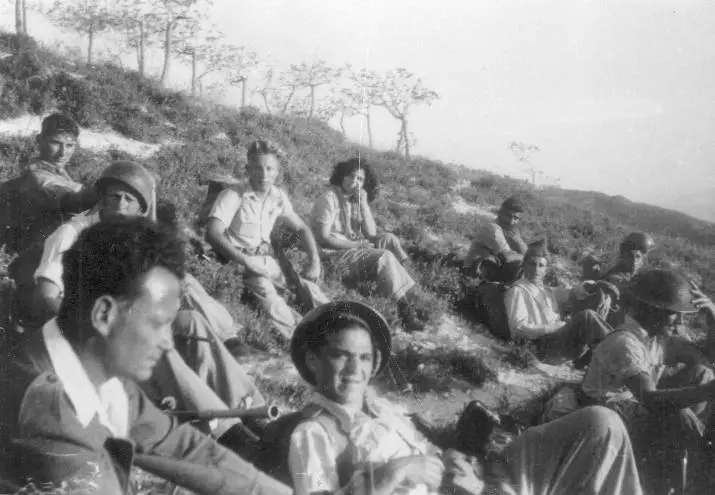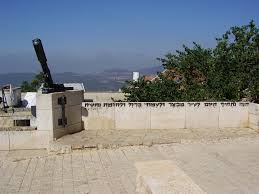The War of Independence: Operation “Yiftach”
(April 30, 1948)
Safed had a pre-war population of 10,000–12,000 Arabs and 1,500 Jews and was the base for 700-800 local and foreign irregulars. Jewish forces were outnumbered over 20 to 1 and the Arab forces promised the Jews that they would slaughter them when they conquered the city. A few aging artillery pieces, named “Davidkas” were smuggled into the Jewish Quarter. The Davidka, first used on March 13, 1948, was a homemade mortar that was inaccurate but extremely loud and effective in demoralizing Arab defenders.

Yigal Allon (left) with members of the Yiftach Brigade following the failed attack on Safed |
On April 30, 1948, Operation “Yiftach” was launched to capture the strategically important town of Safed in the Galilee. On the eve of the British withdrawal from Safed on April 15, the Palmach had infiltrated into Safed, bolstering the defenses of the besieged Jewish quarter. After the British withdrawal, the Arabs took control of tactically advantageous points in the city, including a police fortress on Mount Cana’an, an ancient fortress in the town, and the Shalva House.
On April 28, Haganah forces occupied the Rosh Pinah police fortress, and a neighboring army camp evacuated by the British. On May 1, the Palmach’s 3rd Battalion began shelling the village of Ein al-Zeitun, about 1 km north of Safed, using one of the first Davidkas as well as conventional mortars.
Taking Ein al-Zeitun, along with the village of Birya, allowed the Palmach, led by Yigal Allon, to circumvent Mount Cana’an and, from there, open a corridor leading into the Jewish quarter of Safed. Through this corridor, soldiers brought supplies to the starving quarter. On May 3, a second Palmach unit entered Safed.
Three days later, an attempt to take the citadel failed when the Arabs brought in reinforcements and began using artillery. When an unusual May rain fell after the Davidka was fired, the Haganah spread the rumor that “everyone knows that it rains after a nuclear blast.” The Arabs panicked, thinking the Jews possessed the atomic bomb.
A new attack on May 10 resulted in the capture of the key positions in the town. The Safed Arabs, numbering some 10,000, fled the town, despite Jewish assurances they would not be harmed. This enabled the Jewish forces to take control of a continuous area in eastern and Upper Galilee.

Today, Davidka Square in Safed commemorates the battle.
Sources: Israel Defense Forces.
Laurie Rappeport, Safed Israel.
“Operation Yiftach,” Wikipedia.
Photo of Allon Public domain, via Wikimedia Commons.


